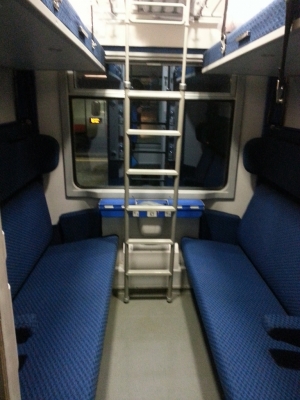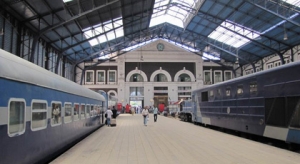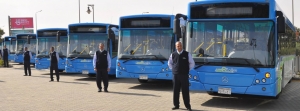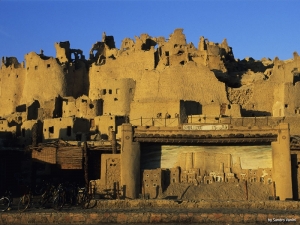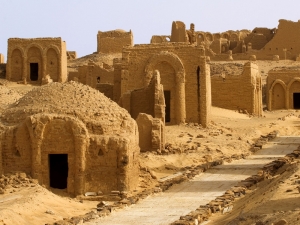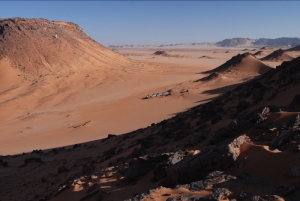+2 0122-345-3028
This email address is being protected from spambots. You need JavaScript enabled to view it.
Super User
Ferry schedule in Egypt
Ferry schedule in Egypt
There are a number of ferry routes in and around Egypt that are open to passengers.
Hurghada – Sharm El Sheilh : The catamaran that runs between hurghada and Sharm el sheikh makes a useful shortcut between mainland Egypt and Sinai. The journey takes just one and a half hours (although delays are common), and makes a preferable alternative to the 12 hour bus journey. For more details including schedules
There was some talk of a ferry from Taba to Aqaba but as of yet this option has not materialized. Some tour operator’s charter small vessels that make the journey but you would need to book as part of a return package through a travel agent. This is the route of choice for operators that run day trips from Sinai to Petra.
The ferry boat from hurghada to sharm , The trip takes around 2.30 hours each way
|
DAY |
DEPARTURE TIME |
ROUTE |
|
SUNDAY |
08.00 |
HURGHADA/SHARM |
|
SUNDAY |
18.00 |
SHARM/HURGHADA |
|
TUESDAY |
08.00 |
HURGHADA/SHARM |
|
TUESDAY |
18.00 |
SHARM/HURGHADA |
|
THURSDAY |
08.00 |
HURGHADA/SHARM |
|
THURSDAY |
18.00 |
SHARM/HURGHADA |
The Ferry boat from Nuweiba /Aqaba –Jordan
Run by Marine, who is the sole agent of AB Maritime, on the Tourist Line between Nuweiba and Aqaba.
The new boat called Babel, a high-speed catamaran latest arrival and added vessel to Arab Bridge Maritime company fleet was recently built only in 2012
In case of a big volume of passengers, they release the Princess boat, for our clients. For that, the timetable can change a bit. Also in case of bad weather and rough sea conditions, changes can occur.
|
DAY |
TIME |
ROUTE |
|
daily (except Saturday) |
12.00 |
Aqaba to Nuweiba |
|
daily (except Saturday) |
15.30 |
Nuweiba to Aqaba |
The journey by the fast ferry to Aqaba lasts for one hour.
Sleeping Trains
Sleeping Trains – information
|
Trains and Cabin Facilities |
We believe in providing our guests with the highest quality of services in order to make their trip as comfortable and memorable as possible. With a staff of well-trained professionals,
we have what it takes to make sure that your first sleeping train experience with us won’t be your last."
Trains
The full capacity of the train is 13 sleeping cars each, which contains 10 double cabins, in addition to an exclusive CLUB CAR.
Cabin Equipment
- Every Cabin has a connecting door with the next cabin, to be used if connecting Cabins are required.
- Cabins are equipped with basins, razor plugs, tap water, soap & towels.
- A luggage compartment is available on the top of the door.
Club Car
After having dinner, you can enjoy your time at the Club Car with its stylish design, which is equipped to offer your choice of drinks, served either at the bar, or in the comfort of your private cabin.
Each cabin has the following control buttons:
- A music audio volume control.
- Cabin temperature control.
- A private reading lamp control.
- Cabin light.
- Call of steward.
|
Food & meals Onboard the Sleeper Trains |
|
Breakfast
|
Dinner
|
Trains Schedule
|
Train No. |
. |
Dep. |
Arr. |
Dep. |
Arr |
|
84 |
Station |
Cairo |
Luxor |
Luxor |
Aswan |
|
. |
Local Time |
20:00 |
5:05 * |
5:15 |
8:15 |
|
85 |
Station |
Aswan |
Luxor |
Luxor |
Cairo |
|
. |
Local Time |
18:30 |
21:30 |
21:40 |
6:45 * |
|
Train No. |
. |
Dep. |
Arr. |
Dep. |
Arr |
|
86 |
Station |
Cairo |
Luxor |
Luxor |
Aswan |
|
. |
Local Time |
21:10 |
6:10* |
6:20 |
9:30 |
|
87 |
Station |
Aswan |
Luxor |
Luxor |
Cairo |
|
. |
Local Time |
21:20 |
00:40* |
00:50 |
9:30 |
|
Upon request & subject to availability of passengers |
|||||
|
Train No. |
. |
Dep. |
Arr. |
Dep. |
Arr |
.Dep. |
.Arr. |
|
82 |
Station |
Alexandria |
Cairo |
Cairo |
Luxor |
Luxor |
Aswan |
|
. |
Local Time |
17:20 |
20:10 |
20:30 |
5:25 * |
5:35 |
8:50 |
|
83 |
Station |
Aswan |
Luxor |
Luxor |
Cairo |
Cairo |
Alexandria |
|
. |
Local Time |
17:00 |
20:15 |
20:30 |
5:35 * |
6:10 |
9:10 |
|
Train No. |
. |
Dep. |
Arr. |
|
973 |
Station |
Cairo |
Matrouh |
|
Saturday - Monday - Wednesday |
Local Time |
23:00 |
6:00 * |
|
974 |
Station |
Matrouh |
Cairo |
|
Sunday - Tuesday - Thursday |
Local Time |
23:00 |
6:00 * |
Trains Schedule in Egypt
Trains Schedule in Egypt
Egyptian Railways are easily the best way to travel between Cities
Such as Cairo, Luxor, Aswan, Alexandria and port said ( Suez Canal )
The views from the train can be wonderful, especially on the Cairo to Aswan Luxor trains journey
Air-conditioned expresses
Trains are modern and comfortable with 1st and 2nd class plus refreshments.
Ordinary trains are slower and much less comfortable, with 2nd and 3rd class non-air-conditioned. A few trains also have 2nd class air-conditioned.
How to book trains - when in Egypt:
Usually you can buy tickets at the railway station booking office when you get to Egypt, although as this is Egypt, a degree of patience is called for... Cairo main station has several booking windows, one for each class and group of destinations, so check that you are joining the right queue. You can pay for train tickets in Egyptian pounds, except for the deluxe watania Egypt sleeper which must be paid in foreign currency (dollars, euros or pounds sterling).
Alternatively, if you can use a local travel agent to buy tickets on your behalf. This will save you lots of hassle and Basle Except during busy holiday periods, it's not normally too difficult to get 1st class tickets on the day of travel or the day before.
|
Train No. |
Route |
Notes |
|
84 |
Cairo - Luxor - Aswan |
Daily |
|
85 |
Aswan - Luxor - Cairo |
Daily |
|
86 |
Cairo - Luxor - Aswan |
Upon Request |
|
87 |
Aswan - Luxor - Cairo |
Upon Request |
|
82 |
Alexandria - Cairo - Luxor - Aswan |
Daily |
|
83 |
Aswan - Luxor - Cairo - Alexandria |
Daily |
|
773 |
Cairo - Alexandria - Matrouh ( Except Fridays ) |
June through September & Upon Request From (15 Jun - 15 Sep) |
|
774 |
Matrouh - Alexandria - Cairo ( Except Saterdays ) |
June through September & Upon Request From (15 Jun - 15 Sep) |
TRAIN TIME SCHEDULE
|
Train No. |
Dep. |
Arr. |
Dep. |
Arr. |
-- |
-- |
|
|
84 |
Station |
Cairo |
Luxor |
Luxor |
Aswan |
-- |
-- |
|
Local Time |
20:00 |
5:05 |
5:15 |
8:15 |
-- |
-- |
|
|
85 |
Station |
Aswan |
Luxor |
Luxor |
Cairo |
-- |
-- |
|
Local Time |
18:30 |
21:30 |
21:40 |
6:45 |
-- |
-- |
|
|
86 |
Station |
Cairo |
Luxor |
Luxor |
Aswan |
-- |
-- |
|
Local Time |
21:40 |
6:55 |
-- |
-- |
-- |
-- |
|
|
87 |
Station |
Aswan |
Luxor |
Luxor |
Cairo |
-- |
-- |
|
Local Time |
-- |
-- |
20:00 |
5:05 |
-- |
-- |
|
|
Train No. |
Dep. |
Arr. |
Dep. |
Arr. |
Dep. |
Arr. |
|
|
82 |
Station |
Alexandria |
Cairo |
Cairo |
Luxor |
Luxor |
Aswan |
|
Local Time |
17:20 |
20:10 |
20:30 |
5:25 |
5:35 |
8:50 |
|
|
83 |
Station |
Aswan |
Luxor |
Luxor |
Cairo |
Cairo |
Alexandria |
|
Local Time |
17:00 |
20:15 |
20:30 |
5:35 |
6:10 |
9:10 |
|
|
Train No. |
Dep. |
Arr. |
-- |
-- |
-- |
-- |
|
|
773 |
Station |
Cairo |
Matrouh |
-- |
-- |
-- |
-- |
|
Except Fridays |
Local Time |
23:00 |
6:00 |
-- |
-- |
-- |
-- |
|
774 |
Station |
Matrouh |
Cairo |
-- |
-- |
-- |
-- |
|
Except Saterdays |
Local Time |
23:00 |
6:00 |
-- |
-- |
-- |
-- |
Seating Train Schedules in Egypt
From: Cairo To Alexandria
|
Train No |
Train Type |
Time Of Departure |
Duration |
|
905 |
Tourbine |
8:00 |
2:00 Hours |
|
909 |
Spanish |
9:00 |
2:00 Hours |
|
913 |
Spanish |
12:00 |
2:15 Hours |
|
917 |
Tourbine |
14:00 |
2:00 Hours |
|
927 |
Tourbine |
19:00 |
2:00 Hours |
|
925 |
Spanish |
17:00 |
2:15 Hours |
|
921 |
Spanish |
18:00 |
2:15 Hours |
|
934 |
Spanish |
22:30 |
2:15 Hours |
|
901 |
French |
08:15 |
3:00 Hours |
|
907 |
French |
09:30 |
3:00 Hours |
|
911 |
French |
11:00 |
3:00 Hours |
|
923 |
French |
16:00 |
3:00 Hours |
|
931 |
French |
20:00 |
3:00 Hours |
From: Alexandria To Cairo
|
Train No |
Train Type |
Time Of Departure |
Duration |
||
|
906 |
Spanish |
7:00 |
N/A |
N/A |
2:00 Hours |
|
904 |
Tourbine |
8:00 |
N/A |
N/A |
2:00 Hours |
|
916 |
Tourbine |
14:00 |
N/A |
N/A |
2:15Hours |
|
918 |
Spanish |
15:00 |
N/A |
N/A |
2:00 Hours |
|
*986 |
Spanish |
18:00 |
N/A |
N/A |
2:00 Hours |
|
927 |
Tourbine |
19:00 |
N/A |
N/A |
2:00 Hours |
|
*This Train is available from 01 , July to 30, September (Summer) |
|||||
|
From: Cairo To Port Said |
|||||
|
Train No |
Train Type |
Time Of Departure |
Price |
Duration |
|
|
I Class |
II Class |
||||
|
945 |
Express |
6:20 |
N/A |
N/A |
3:30 Hours |
|
971 |
Express |
8:40 |
N/A |
N/A |
3:30 Hours |
|
955 |
Express |
14:30 |
N/A |
N/A |
3:30 Hours |
|
961 |
Express |
19:10 |
N/A |
N/A |
3:30 Hours |
|
From: Cairo To Ismailia |
|||||
|
Train No |
Train Type |
Time Of Departure |
Price |
Duration |
|
|
I Class |
II Class |
||||
|
947 |
Express |
7:30 |
N/A |
N/A |
3:00 Hours |
|
953 |
Express |
12:40 |
N/A |
N/A |
3:00 Hours |
|
957 |
Express |
15:45 |
N/A |
N/A |
3:00 Hours |
|
959 |
Express |
18:45 |
N/A |
N/A |
3:00 Hours |
|
963 |
Express |
22:00 |
N/A |
N/A |
3:00 Hours |
|
From: Cairo To Suez |
|||||
|
Train No |
Train Type |
Time Of Departure |
Price |
Duration |
|
|
I Class |
II Class |
||||
|
305 |
Express |
6:30 |
N/A |
N/A |
3:00 Hours |
|
311 |
Express |
9:20 |
N/A |
N/A |
3:00 Hours |
|
313 |
Express |
13:20 |
N/A |
N/A |
3:00 Hours |
|
315 |
Express |
16:15 |
N/A |
N/A |
3:00 Hours |
|
317 |
Express |
18:45 |
N/A |
N/A |
3:00 Hours |
|
319 |
Express |
21:45 |
N/A |
N/A |
3:00 Hours |
|
From: Cairo To Luxor |
|||||
|
Train No |
Train Type |
Time Of Departure |
Price |
Duration |
|
|
I Class |
II Class |
||||
|
980 |
Express |
7:30 |
N/A |
N/A |
12:00 Hours |
|
996 |
Express |
22:00 |
N/A |
N/A |
12:00 Hours |
|
1902 |
Express |
00:30 |
N/A |
N/A |
12:00 Hours |
|
From: Cairo To Aswan |
|||||
|
Train No |
Train Type |
Time Of Departure |
Price |
Duration |
|
|
I Class |
II Class |
||||
|
980 |
Express |
7:30 |
N/A |
N/A |
15:00 Hours |
|
996 |
Express |
22:00 |
N/A |
N/A |
15:00 Hours |
|
1902 |
Express |
00:30 |
N/A |
N/A |
15:00 Hours |
Bus Schedule and Timetable
Bus Schedule and Timetable
Egypt's public transport network is well-developed and offers great service. Travelers to Egypt are free to come and go without any restrictions except when needing to have a travel permit for passing through the desert. An efficient rail network links the Nile Valley, Delta, and Canal Zone, and anywhere else is easily accessible via bus. Most cities in Egypt have a well-developed bus system, but travelers mostly use them in Cairo and Alexandria. The buses are not considered visitor-friendly since most of the sign and information boards are only in Arabic.
The three major bus companies that operate in Egypt are all based out of Cairo. Their names are the Upper Egypt Bus company which operates in Nile Valley, Fayoum, inner oases, and the Red Sea Coast down to El-Quseir. The second company is the East Delta Bus Company which offers services in Sinai and the Canal Zone. The third one, the Middle Delta Bus Company, offer regular services in Alexandria, Marsa Matrouh, Siwa and the Nile Delta. Another firm that works independently is El Gouna offers bus service from Cairo to Hurghada and Sharm el-Sheikh. Most Egyptian buses are air-conditioned and fast. When taking a local bus over short distances, you might need to travel in a non-ac bus. There are also super jet buses which have air-conditioners, toilets, videos and expensive snacks. Most cities in Egypt have a single bus depot, but in cities like Cairo and Alexandria, you can find many. Finding English and French speaking staff is not difficult but the schedules are usually displayed in Arabic only. However, bus information can be easily obtained from hotels in Sinai and the oases, as well as tourist offices in Luxor, Aswan, and the oases. Instead of buying tickets at the bus terminals, book them 24 hours in advance for long-haul services or air-conditioned buses. In the provinces, meanwhile, booking tickets can be done an hour or so before departure, or on the bus itself in the case of through services, which are often standing-room-only when they arrive. Passengers on a/c services are usually assigned a seat, but seats on “local” buses are taken on a first-come, first-served basis. Fares are very reasonable for bus travel in the country.
LEAVING FROM THE TOURGOMAN BUS STATION - TERMINAL NEAR RAMSES STATION
|
DESTINATION |
DEPARTURE |
|
|
Suez |
6 am-8:30 pm (every 1/2 hour-both ways) |
|
|
Ismailia |
6:30am-8:30pm(every 1/2 hour-both ways) |
|
|
Port Said |
6:30am-7 pm (every 1/2 hour-both ways) A/C Superjet bus 10 am, 3pm and 4:30 pm |
|
|
Damietta |
6:00 am-7 pm (every 1/2 hour - both ways) |
|
|
El-Mansoura |
6 am-8 pm (every 1/2 hour - both ways) Superjet bus (6:30 am-5:30 pm) |
|
|
Ras El Bar |
7:15am-5:15pm(every 1/2 hour-both ways) |
|
|
Gamasa |
7:20 am-6 pm |
|
|
DESTINATION |
DEPARTURE |
|
Suez |
6 am-8:30 pm (every 1/2 hour-both ways) |
|
Ismailia |
6:30am-8:30pm(every 1/2 hour-both ways) |
|
Port Said |
6:30am-7 pm (every 1/2 hour-both ways) A/C Superjet bus 10 am, 3pm and 4:30 pm |
|
Damietta |
6:00 am-7 pm (every 1/2 hour - both ways) |
|
El-Mansoura |
6 am-8 pm (every 1/2 hour - both ways) Superjet bus (6:30 am-5:30 pm) |
|
Ras El Bar |
7:15am-5:15pm(every 1/2 hour-both ways) |
|
Gamasa |
7:20 am-6 pm |
|
LEAVING FROM AL-AZHAR TERMINAL
|
||
|
DESTINATION |
DEPARTURE |
|
|
Bahariya Oasis |
12 noon, 9 am (Fridays only) 8 am (Mon,Thurs.& Sat.) |
|
|
Farafra Oasis (via Bahariya Oasis) |
8 am Mon., Thurs. Sat. |
|
|
Kharga Oasis (via Assyut) |
7 am, 10 am, 7 pm and 8 pm daily |
|
|
Dakhla Oasis |
7 am and 7 pm |
|
|
LEAVING FROM THE ABDEL MOUNEEM RIYAD BUS TERMINAL – NEAR MIDAN EL TAHRIR
|
||
|
DESTINATION |
DEPARTURE |
|
|
Alexandria |
Every half-hour from 5:30 am to 11 pm Super jet Bus West Delta Bus Co. |
|
|
Mersa Matrouh |
7:15 am, 7:30 am, 7:45 am, 8:00 am, 8:30 am and 5:00 pm |
|
|
Port Said |
6 am, 2 pm Superjet bus |
|
|
Hurghada |
8 am Nile Bus Co. and Upper Egypt Bus Co. |
|
|
Luxor |
9:15 am Nile Bus Co. and Upper Egypt Bus Co. |
|
|
Aswan |
5 pm 7 pm Nile Bus Co. and Upper Egypt Bus Co. |
|
|
LEAVING FROM THE ABBASSIA BUS STATION – RAMESIS STREET
|
||
|
DESTINATION |
DEPARTURE |
|
|
Rafah |
8:00 am, 12 nn, 4 pm |
|
|
Al-Arish |
8:00 am, 12 noon, 4 pm |
|
|
Sharm El-Sheikh |
7 am, 8:30 am, 11am, 2 pm, 4 pm 11:30 pm 12 mn |
|
|
Dahab |
8:30 am, 2 pm, 5 pm 12 mn |
|
|
Taba |
8 am 11 pm |
|
|
Nuweiba |
8 am 11 pm |
|
|
St. Catherine |
11:30 am |
|
|
Jordan (via Nuweiba) |
8 pm |
|
|
LEAVING FROM THE SINAI BUS TERMINAL
|
||
|
DESTINATION |
DEPARTURE |
|
|
Sharm El Sheikh (via El Tor) |
7:30 am, 8:30 am, 11:00 am, 4:00 pm, 11:00 pm, 11:30 pm and 11:45 pm |
|
|
Dahab |
2:00 pm, 5:00 pm, 12 mn |
|
|
Nuweiba |
8 am, 9 am, 9 pm 11 pm |
|
|
Taba (via Nuweiba) |
8:00 am, 11:00 pm |
|
|
St. Catherine’s Monastery |
9 am |
|
|
LEAVING FROM THE AHMED HELMI TERMINAL (BEHIND RAMSES STATION)
|
||
|
DESTINATION |
DEPARTURE |
|
|
Luxor |
6:30 pm 8 pm and 9 pm 10 pm Superjet Bus |
|
|
Aswan |
5 pm 7 pm 10 pm Superjet Bus |
|
|
Hurghada |
5 pm, 8:30 pm and 9:15 pm Superjet Bus |
|
|
Minya |
hourly (non A/C bus) |
|
|
Assyut |
8 am daily (non A/C bus) |
|
|
Sohag |
6 am daily (non A/C bus) |
|
|
Beni Suef |
every 30-min from 6 am to 6 pm (non A/C bus) |
|
|
Fayoum City |
every 15-30 min from 6:15 am to 6:45 pm (non A/C bus) |
|
|
Zagazig (Eastern Delta) |
every 30 min from 8:30 am to 6 pm (non A/C bus) |
|
|
FROM EL TOR – SOUTH SINAI |
||
|
DESTINATION |
DEPARTURE |
|
|
Sharm El-Sheikh |
7:30 am, 8:30 am and 11:00 am |
|
|
Sharm El-Sheik / Dahab |
2:00 pm, 5:00 pm and 12:00 am |
|
|
FROM TABA SOUTH SINAI |
||
|
DESTINATION |
DEPARTURE |
|
|
Nuweiba |
9 am. 10 am, 2 pm and 3 pm |
|
|
Sharm El-Sheikh and Dahab |
9 am and 3 pm |
|
|
St. Catherine’s |
10 am |
|
|
Cairo |
10 am and 2 pm |
|
|
Suez |
7 am |
|
|
FROM NUWEIBA SOUTH SINAI |
||
|
THE TERMINAL IS AT THE PARKING LOT OUTSIDE HELNAN HOTEL |
||
|
DESTINATION |
DEPARTURE |
|
|
Taba |
11:00 pm |
|
|
Dahab |
7 am and 3:30 pm; 1 hr |
|
|
Na’ama Bay |
7 am and 3:30 pm; 3hr |
|
|
Sharm El-Sheikh via Dahab |
7 am, 2 pm and 4 pm ; 3 hr |
|
|
St. Catherine |
6:30 am, 11 am and 2 pm |
|
|
Suez |
5:30 am, 6:30 am and 7:30 am |
|
|
Cairo |
10:30 am and 2:30 pm |
|
|
FROM SHARM EL-SHEIKH |
||
|
DESTINATION |
DEPARTURE |
|
|
Taba |
9:00 am |
|
|
Cairo |
7 am, 10 am and 1 pm 4:30 pm 11:30 pm and 12 am |
|
|
St.Catherine’s Monastery |
7:30 am |
|
|
Dahab |
8 am, 9 am, 3 pm and 5 pm |
|
|
Nuweiba |
9 am and 5 pm |
|
|
Suez |
9 am and 11 pm |
|
|
Ismailia |
9:30 pm |
|
|
FROM SUEZ |
||
|
LEAVING FROM THE ARBA’IN TERMINAL |
||
|
DESTINATION |
DEPARTURE |
|
|
El Tor (via Aburedes) |
7:00 am-4:00pm |
|
|
Cairo |
every half-hour from 6 am to 6 pm |
|
|
Ismailia |
every 15 min. from 6 am to 4 pm |
|
|
Port Said |
6:30 am, 12 noon and 3:30 pm |
|
|
Sharm El-Sheikh (via El Tor) |
11:00 am, 1:30 pm and 3:00 pm |
|
|
Sharm El Sheikh (with stops at Dahab and Nuweiba) |
10:30 am |
|
|
St. Catherine |
2:30 pm |
|
|
Nuweiba (via Sharm El-Sheikh) |
11:00 am |
|
|
Nuweiba (via El Naqab) |
3:00 pm |
|
|
Taba (via Nuweiba) |
3:00 pm |
|
|
INTERNATIONAL BUSES |
||
|
LEAVING FROM CAIRO SHERATON IN DOKKI
|
||
|
DESTINATION |
DEPARTURE |
|
|
Tel Aviv and Jerusalem (via El Arish and Rafah) |
5:30 am daily (except Sat.) |
|
|
Tel Aviv and Jerusalem (via Taba and Eliat) |
5:30 pm (Mon and Thurs. only) |
|
|
LEAVING FROM THE SINAI BUS TERMINAL |
||
|
DESTINATION |
DEPARTURE |
|
|
Tel Aviv and Jerusalem (via Rafah) |
8 am (Mon and Wed. only) |
|
|
Riyadh, Jeddah and Libya (all via Nuweiba-Aqaba) |
||
|
Kuwait |
8-9 pm daily East Delta (tel. 2 (02) 392-3027) |
|
|
Jeddah |
5 pm daily except Fri & Sat. |
|
|
Riyadh (with Al Fwzan) |
7:30 am and 9:30 am (Tues, Thurs, Sat. & Sun) |
|
|
Benghazi (with East Delta) |
10 am daily except Fri. 8 pm A/C buses |
|
|
Tripoli (with East Delta) |
10 am daily except Fri. |
|
|
LEAVING FROM MIDAN ALMAZA IN HELIPOLIS NEAR CAIRO AIRPORT
|
||
|
DESTINATION |
DEPARTURE |
|
|
Jordan, Syria, Saudi Arabia and Libya |
||
|
by: Arab Union Bus Co. (tel. 2 (02) 290-9017 or 772-663) |
||
|
Amman |
7 am (Mon., Tues. & Thurs. ) and 10 pm (Sat.) |
|
|
Damascus |
10 pm (Thurs) |
|
|
Tripoli |
7:30 am daily |
|
|
Tripoli (via Benghazi) |
7:30 am daily |
|
|
by: Al-Taha Hodat 1 Midan Ismailiya (tel.2 (02) 667-447)
|
||
|
Benghazi |
10 pm daily and 2 pm (Tues, Thurs. and Fri.) |
|
|
Amman and Damascus |
9 pm daily except Fri |
|
Transportation in Egypt
Transportation in Egypt
Egypt has approximately 8600 km (about 5300 mi) of railroads. The principal railway line links Aswan and points north in the Nile Valley to Alexandria on the Mediterranean coast. The inland waterways of Egypt including the Nile, navigable throughout its course in the country, the approximately 1600 km (about 1000 mi) of shipping canals, and the more than 17,700 km (more than 11,000 mi) of irrigation canals in the Nile delta—are used extensively for transportation. Camel caravans are employed to a limited extent in the desert.
Two highways connect Cairo with Alexandria. Other highways connect Cairo to Port Said, Suez and Al Fayoum. The total length of highways and roads is about 38,000 km (about 23,600 mi), of which about 18,000 km (about 11,200 mi) are highways. International airlines provide regular services between Cairo and Alexandria and major world centres. Egypt-Air, the government-owned airline, also provides domestic and foreign services; the country has about 80 airfields. The major port is Alexandria, followed by Port Said and Suez, all of which are served by numerous shipping companies. The Suez Canal, which was closed from 1967 until mid 1975, produces substantial annual toll revenues. In the early 1990s about 16,600 vessels used the canal each year.
Buses:
Bus services are to be found everywhere in Egypt. Deluxe buses, which run between most of the main towns and cities, are air-conditioned and fairly comfortable. The basic intercity bus service is less luxurious and is often crowded.
Tickets can be bought at a bus station window, or, sometimes, on the bus. Regular ticket inspections are the norm. On longer runs, seats can be booked in advance, but for short distances those who board first will get the best seats.
Visitors should be a little wary of 'video buses' which, despite their superior speed and cleanliness, show non-stop movies at high volume, and are not for those with delicate eardrums.
Taxis:
Service (pronounced ser-vees) taxis are usually Peugeot Hyundai vehicles which hold about 2 or 3 people and which tend to congregate near bus and railway stations.
This is a relatively fast way to travel between cities, but the driver will not begin the journey until his vehicle is full, which can be inconvenient. The whole vehicle can be hired for an increased fare, however
A larger version of the service taxi is the microbus, which is built to hold about 12 people and often holds twenty or more. Needless to say, it is not particularly comfortable and passengers are often charged extra for luggage. Microbus fares are roughly the same as service taxis, but there are fewer routes.
Regular taxis operate in most Egyptian cities. In Cairo these are black and white, and in Alexandria black and orange. Although most are fitted with a meter, many are non-functional and arguments between passenger and driver over the correct fare are quite common. As in all Middle Eastern countries, it is probably best to avoid this by negotiating the fare before beginning your trip.
Rail:
Egypt's railway system has over 5,000km of track, connecting almost every major city and town. Timetables are generally reliable, although the system itself is in need of some modernization.
First-class rail travel is either by wagon-lit, which has air-conditioning, hot and cold running water in each sleeper compartment and a full meal service; or by first-class seated accommodation. Second-class travel is divided into two sub-sections: with or without air-conditioning. Third-class travel is extremely basic, very cheap and can be crowded.
The Cairo metro:
The city of Cairo has its own metro system -- the only one in Egypt. It is fast, cheap and uncrowded, and has done a great deal to reduce the volume of traffic in the city centre.
Its single line of stations stretches for 43km from: I in the south to Al-Marg near:: I. Only five stations in the centre of Cairo run underground.
Two more lines are scheduled to open at a future date, and plans for a similar system in Alexandria are in the early stages.
The Alexandria tram:
Alexandria have their own tram networks. In Alexandria, the trams are often fairly crowded, but the network is extensive and the system is reliable. In Cairo, the system is smaller, consisting of only three lines.
Car rental:
Roads are hazardous and local driving skills leave a great deal to be desired -- roadside heaps of post-accident scrap metal constantly bear witness to this.
Visitors are strongly advised against hiring a car themselves, although there are plenty of rental agencies in all major cities. Driving at night is particularly dangerous, as many drivers do not use headlights.
Cruising the Nile:
This is a popular tourist activity, and so the quality and price of organized cruises can vary.
At the top of the range, cruises can be booked through most of the major hotels; others can be obtained more cheaply through numerous Cairo travel agencies, and can cover full-day excursions through to a four-day sightseeing trip.
The most common means of transport up and down the Nile is by the ancient sailing boats known as feluccas. A felucca ride can be arranged for a few hours and is a peaceful way of seeing the Nile traffic and scenery. Sunset is the recommended time to do this
Mounted transportation:
Camels and donkeys can be hired on an hourly-basis to enable visitors to wander around many of Egypt's ancient sites. A guide will usually accompany you.
Entrees Fees Tickets 2019
Entrance Fees Tickets for Monuments in Egypt
All pricing is quoted in Egyptian pounds except where otherwise noted.
For the latest exchange rate of Egyptian pounds to most other currencies, www.oanda.com Note: Most tombs do not allow flash photography.
Basic Exchanges Rates
1 US$ = 16 LE - 1 Euro = 18 LE – 1 GBP = 20 LE
|
Alexandria |
Entry Price |
Still/Video Photography |
|
Catacombs of Kom El-Shoqafa |
80.00 |
No Cameras |
|
Fort Qait Bey |
80.00 |
Free |
|
Greco-Roman Antiquities Museum |
100.00 |
Currently Closed |
|
Montazah Palace Gardens |
40.00 |
Free |
|
Pompey's Pillar |
70.00 |
Free |
|
Roman Amphitheater |
80.00 |
Free |
|
National Museum |
80.00 |
No Flash |
|
Alexandria Library |
100.00 |
Free |
|
Aswan |
Entry Price |
Still/Video Photography |
|
Abu Simbel Temple |
280.00 |
|
|
Botanical Gardens |
80.00 |
|
|
High Dam |
80.00 |
|
|
Nubian Museum |
100.00 |
|
|
Philae Temple |
180.00 |
|
|
Philae Temple Sound and Light Show |
400.00 |
|
|
Tombs of the Nobles |
100.00 |
|
|
Unfinished Obelisk |
80.00 |
|
|
Cairo |
Entry Price |
Still/Video Photography |
|
Agricultural Museum |
100.00 |
|
|
Citadel |
180.00 |
|
|
Coptic Museum |
100.00 |
|
|
Dr. Ragab's Papyrus Institute |
100.00 |
|
|
Dr. Ragab's Pharaonic Village |
300.00 |
|
|
Egyptian Antiquities Museum |
200.00 |
90.00/Unknown |
|
Antiquities Museum Mummies Hall |
180.00 |
|
|
Gayer Anderson House |
100.00 |
|
|
Islamic Art Museum |
80.00 |
|
|
Mahmoud Khalil Museum |
80.00 |
|
|
Mohammed Nagui Museum |
80.00 |
|
|
Makhtar Museum |
80.00 |
|
|
National Museum of Egyptian Modern Art |
100.00 |
|
|
October War Panorama |
100.00 |
|
|
Pyramids of Giza |
200.00 |
|
|
Entering Pyramid of Khufu |
400.00 |
|
|
Entering Pyramid of Khafre |
100.00 |
|
|
Entering Pyramid of Menkaure |
100.00 |
|
|
Railway Museum |
100.00 |
|
|
Solar Boat Museum |
100.00 |
|
|
Near Cairo |
Entry Price |
Still/Video Photography |
|
Saqqara |
150.00 |
|
|
Dahshur |
80.00 |
|
|
Memphis |
80.00 |
|
|
Hurghada |
Entry Price |
Still/Video Photography |
|
Museum of Marine Biology |
100.00 |
|
|
Red Sea Aquarium |
100.00 |
|
|
Luxor |
Entry Price |
Still/Video Photography |
|
East Bank |
||
|
Karnak Temple |
200.00 |
OK |
|
Karnak Temple Sound and Light Show |
300.00 |
|
|
Luxor Temple |
160.00 |
OK |
|
Luxor Museum |
140.00 |
10.00/100.00 |
|
Mummification Museum |
100.00 |
10.00/100.00 |
|
West Bank |
||
|
Colossi of Memnon |
Free |
OK |
|
Valley of the Kings |
240.00 |
|
|
Combo Pricing any Three of the Below |
240.00 |
|
|
Ramses I (KV16) |
100.00 |
|
|
Ramses III (KV11) |
||
|
Ramses VII (KV1) |
||
|
Ramses IX (KV6) |
||
|
Seti II (KV15) |
||
|
Amenhotep II (KV35) |
||
|
Tausert/Sethnakhte (KV14) |
||
|
Merneptah (KV8) |
||
|
Tuthmosis III (KV34) |
||
|
Saptah (KV47) |
||
|
Individual Pricing |
||
|
Ay |
80.00 |
5.00/100.00 |
|
Temple of Hatshepsut |
140.00 |
OK |
|
Ramesseum |
80.00 |
OK |
|
Medinat Habo |
100.00 |
OK |
|
Deir el-Medina ( Sennedjem, Inherkau, Temple) |
100.00 |
5.00/100.00 |
|
Deir el-Median Pashedu |
100.00 |
5.00/100.00 |
|
Temple of Seti I |
75.00 |
OK |
|
Tomb of Tutankhamun (KV54) |
300.00 |
No |
|
Valley of the Queens |
120.00 |
|
|
Titi, Amenherkhopshef, Kahemwaset |
120.00 |
5.00/100.00 |
|
Nefertari Tomb |
1400.00 |
No |
|
Tombs of the Nobles |
80.00 |
|
|
Nakht, Menna |
80.00 |
No |
|
Rekmire, Sennefer |
80.00 |
5.00/100.00 |
|
Ramose, Userhet, Khaemhet |
80.00 |
5.00/100.00 |
|
Khons, Userhet, Benia |
80.00 |
5.00/100.00 |
|
Pabasa |
80.00 |
5.00/100.00 |
|
Keref, Anchhor |
80.00 |
5.00/100.00 |
|
Khokha Area |
80.00 |
5.00/100.00 |
|
Roy, Shroy |
80.00 |
5.00/100.00 |
|
North and South of Luxor |
Entry Price |
Still/Video Photography |
|
Abydos |
120.00 |
|
|
Dendera |
120.00 |
|
|
Esna |
80.00 |
|
|
Edfu |
180.00 |
|
|
Kom Ombo |
140.00 |
|
|
Sinai |
Entry Price |
Still/Video Photography |
|
Ras Mohammed National Park |
$20.00 |
|
|
St. Catherine's Monastery |
$20.00 |
|
Ramadan Holy Month
Ramadan Holy Month in Arabs Countries and Egypt
Ramadan dates
2018 (1438): June 15- July 15
2019 (1439): May 20 – June 20
2020 (1440): April 20 –May 20
The festival of Eid ul-Fitr is held after the end of Ramadan and may last several days. Exact dates depend on astronomical observations and may vary from country to country. Ramadan is the ninth month of the Islamic calendar and the most important month in the Islamic Calendar for Muslims, the majority religion in Egypt. Commemorating the time when God revealed the Qur'an to Mohammed, during this holy month, Muslims abstain from eating, drinking or smoking until after sundown on each day. Although strict adherence to Ramadan is for Muslims only, some Muslims appreciate that non-Muslims do not take meals or smoke in public places. During Ramadan, many restaurants and cafes won't open until after sundown. Public transport is less frequent, shops close earlier before sunset and the pace of life (especially business) is generally slow.
As expected, exactly at sunset minute, the entire country quiets down and busy itself with the main meal of the day (iftar or breaking-fast) that are almost always done as social events in large groups of friends. Many richer people offer (Tables of the Gracious God) in Cairo's streets that cater full-meals for free for the passers-by, the poorer ones or workers who couldn't leave their shifts at the time. Prayers become popular 'social' events that some like to enrich with special food treats before and after. An hour or two later, an astonishing springing to life of the cities takes place. Streets sometimes richly decorated for the whole month have continuous rush hours till very early in the morning. Some shops and cafes make the biggest chunk of their annual profit at this time of year. Costs of advertising on television and radio soars for this period and entertainment performances are at their peak.
Siwa
The temple of the Oracle
Temple of the Oracle from the 26th dynasty sits in the northwest corner of the ruins of Aghurmi village.
Built in the 6th century BC, probably on top of an earlier temple, it was dedicated to Amun
(occasionally referred to as Zeus or Jupiter Ammon) and was a powerful symbol of the town’s
wealth. It is believed Alexander the Great was declared son of Amun in this temple.
There are many stories about the foundation of the temple. One tells of two priestesses who were
banished from Thebes to the desert. One founded the Temple of Dodona in Greece, the other the
Temple of the Oracle here in Aghurmi. One of the most revered oracles in the ancient Mediterranean,
its power was such that some rulers sought its advice while others sent armies to destroy it. Although
the treasure hunters have been at work here and the buttressed temple was poorly restored in the 1970s,
it remains an evocative site, steeped in history. Surrounded by the ruins of Aghurmi, it has awesome views over the Siwan oasis palm-tops.
Gebel El Mawta
This small hill, at the northern end of Siwa Town, is honeycombed with rock tombs peppered with
wall paintings. Its name, Gebel Al Mawta, means ‘Mountain of the Dead’ and most of the tombs here
date back to the 26th dynasty, Ptolemaic and Roman times. Only 1km from the Centre of town, the
tombs were used by the Siwans as shelters when the Italians bombed the oasis during WWII.
The best paintings are in the Tomb of Si Amun, where beautifully colored reliefs portray the dead
man – thought to be a wealthy Greek landowner or merchant – making offerings and praying to
Egyptian gods. Also interesting are the unfinished Tomb of Mesu-Isis, with a beautiful depiction of
cobras in red and blue above the entrance; the Tomb of Niperpathot, with inscriptions and crude
drawings in the same reddish ink you can see on modern Siwan pottery; and finally the Tomb of the
Crocodile, who’s badly deteriorating wall paintings include a yellow crocodile representing the god
Sobek.
Kharga Oasis
Kharga Oasis
Kharga Oasis is the last oasis on the loop before the Nile Valley. It seems to have had the longest association with ancient Egypt. It is also the place where Christians were banished in the 4th and 5th centuries and as a souvenir of the time boasts one of the largest ancient Christian cemeteries in the world: Bagawat.
Kharga also claims the first five star resort with swimming pool and air conditioning. At first glance Kharga looks disappointing for its main village is a replica of a Nile Valley town, but one must dig deeper.
Kharga used to be the last but one stop of The Forty Days Road, the infamous slave-trade route between North Africa and the tropical south. Today, it is the biggest New Valley oasis and its modern city houses 60,000 people, including 1,000 Nubians who moved here after the creation of Lake Nasser.
Outside the main center is the Temple of Hibis, built on the site of an 18th dynasty settlement of Saites, Persians and Ptolemies. One of the few Persian monuments in Egypt, the 6th century BC temple is well preserved with painted vultures and huge reliefs of Darius greeting Egyptian gods on the outer walls. The temple is dedicated to the Theban triad, consisting of the gods, Amun, Mut and Khonsu, whose reliefs are in very good condition.
Ten kilometers away, the Necropolis of al-Bagawat contains 263 tombs (mostly dating from the 4th through 6th centuries, AD) in the pattern of domed chambers, as well as 120 Nestorian mud brick chapels where the dead could be worshipped. Some of the tombs have paintings of biblical scenes. In the center is a church dating back to the 11th century AD. It is regarded as one of the oldest churches in Egypt.
Some of the more interesting structures located here include the Chapel of Peace, with paintings of the apostles and with images of Adam and Eve and the Ark on its dome. There is also the Chapel of Exodus, with better preserved pictures, and Old Testament biblical stories as well as frescoes of pharaonic troops pursuing the Jews, led by Moses, out of Egypt. Another example is the Chapel of the Grapes, with paintings of grapevines. Pharaonic monuments include the al-Ghuwaytah Temple which dates from 522 BC and the Temple of Amenebis.
The thermal springs at Bulaq and Nasser villages to the south, are famous for water temperatures of up to 43 C and reputed to be suitable for the treatment of rheumatism and allergies.
Camping facilities are available near both villages.
Further south is Baris Oasis, the second largest settlement in Kharga. Houses designed in traditional Nubian style.
Ancient monuments include the Temple of Dush, dedicated to Isis and Serapis. Its name derives from Kush, the ancient Sudanese capital which traded with Egypt along the Nile. Dush was a religious, military and civilian complex that primarily developed as the result of the slave trade, and was a staging point for caravans that either headed to Assiut or Esna.
Built for Isis and Serapis, this temple is surrounded by a mud-brick fortress. It was built during the rule of Domitian and Trajan (1st century) and decorated during the rule of Hadrian, though apparently the site was occupied from the Ptolemaic period. Entering the temple through any one of several gates is the barrel-vaulted sanctuary which is made up of two connecting rooms and has a vaulted ceiling. On either side of the sanctuary are chapels.
Archeologists are still unearthing the ancient city of Kysis and elaborate system of clay pipes and abandoned Christian church, suggest that Kysis was abandoned when its underground springs dried up but the exact date remains a mystery
Kharga Oasis’s greatest treasures, in addition to its marching rows of crescent sand dunes, are the Roman fortresses scattered along a famous slaver’s road called the Darb el Arbain, the 40 Days’ Road. These unexplored fortresses rise to four and five stories. And there are dozens of them.
Gilf El Kebir
Gilf El-Kebir
If you ever dreamt of experiencing the story of The English Patient, the acclaimed movie based on the 1992 novel, visit Gilf El-Kebir. A round trip between Cairo and Gilf El-Kebir is about 2000 km; you’ll need plenty of fuel, snacks and water!
Follow the steps of Almasy, the Hungarian explorer whose story is narrated in the English Patient by exploring the Regenfeld and the Swimmers Cave. Go deeper into the Gilf El-Kebir National Park to discover more of the hidden secrets of this barren land.
The Gilf El-Kebir is a sandstone plateau located in the southwest corner of the Western Desert. The rocky surface slopes south-eastward are partially covered by sand because the Great Sand Sea to the north is gradually encroaching on the plateau. The area is extremely arid but it supports the Barbary Sheep, and several species of reptiles as well as small birds, among the latter is the ubiquitous White-crowned Black Wheatear. You’ll find ancient rock art in Shaw’s cave, and El-Mestikawi cave depicting several types of cattle that attest to a wetter period in prehistoric times.
It is advisable to visit Gilf El-Kebir in the cooler months of the year, from October to May, that is. Temperatures in summer can reach an intolerable maximum of 35-45 C.

